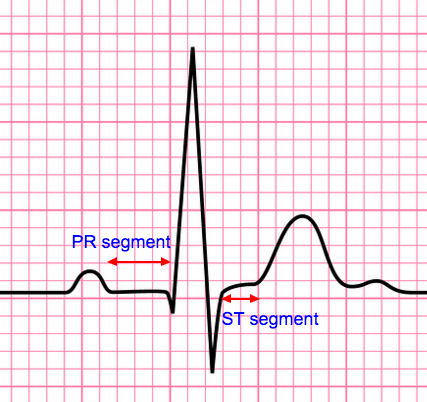The Basics of ECG Interpretation (Part 3 – Waves, Segments & Intervals)
- Izaskun Telliu

- 19 dic 2016
- 4 Min. de lectura

Waves
As the ECG trace is recorded there are a series of upwards and downwards deflections created that represent atrial and ventricular depolarization and repolarization. These are known as the ECG waves.
The P wave is the first positive deflection on the ECG. It is a small smooth contoured wave and represents atrial depolarization. Atrial repolarisation is not visible as the amplitude is too small. The normal P wave is:
< 120 ms in duration (3 ‘small squares’)
< 2.5 mm in amplitude in the limb leads
< 1.5 mm in amplitude in the chest leads
Positive in lead II and negative in lead AVR
The second wave seen on the ECG is the QRS complex. The QRS complex is a series of 3 deflections that represents ventricular depolarization. It is less than 0.12 seconds in duration (3 ‘small squares’) under normal circumstances.
By convention the first deflection in the complex, if it is negative, is called a Q wave. A Q wave represents the normal left-to-right depolarization of the interventricular septum. A normal Q wave is:
< 40 ms wide (1 ‘small square’)
< 2 mm in amplitude
< 25% of the depth of the QRS complex
Small Q waves are usually normal, but if they exceed the normal criteria listed above they are termed ‘pathological Q waves’ and can be indicative or an evolving or past myocardial infarction.
The first positive deflection in the complex is called an R wave. This is the largest wave in the QRS complex and represents depolarization of the thick ventricular walls.
A negative deflection after an R wave is called an S wave. This small wave represents depolarization of the Purkinje fibres. S waves travel in the opposite direction to the R waves because the Purkinje fibres spread throughout the ventricles from top to bottom and then back up though the walls of the ventricles.
The positive deflection seen on the ECG tracing following the QRS complex is called a T wave. T waves represent ventricular repolarization. A normal T wave is:
Positive in all leads except V1 and AVR
< 5 mm in amplitude in the limb leads
< 15 mm in amplitude in the chest leads

Figure 1. The ECG waves. © Medical Exam Prep
This ECG can be further divided into segments and intervals. These are useful when assessing for certain types of pathology. It is important to recognize that segments and intervals are different entities. Segments should be examined to look for deviation from the isolectric line whilst intervals should be analysed with reference to their duration.
Segments
The PR segment commences at the endpoint of the P wave and ends at the start of the QRS complex. It represents the duration of the conduction of electrical impulses from the AV node to the bundle branches and Purkinje fibres. The PR segment is isoelectric under normal circumstances but deviation can occur in the presence of pericarditis and atrial ischaemia.
The other major segment is the ST segment, which commences at the end of the S wave (the J point) and ends at the beginning of the T wave. The ST segment is also isolelectric under normal circumstances as the atria are relaxed and the ventricles contracted and there is therefore no visible electrical activity. The most important causes of ST segment deviation are myocardial ischaemia and infarction, with ischaemia causing ST depression and infarction causing ST elevation.
The TP segment commences at the end of the T wave and ends at the beginning of the P wave. This segment represents the isolectric line and shoud always be the baseline point of reference when assessing the other segments.

Figure 2. The ECG segments. © Medical Exam Prep
Intervals
The PR interval commences at the start of the P wave and ends at the start of the QRS complex. It represents the time taken for the electrical impulse to be conducted through the AV node. It is between 0.12 and 0.20 seconds (3-5 ‘small squares’) under normal circumstances. The PR interval is prolonged (> 0.20 seconds) in the presence of 1st degree heart block and is shortened (< 0.12 seconds) in the presence of certain pre-excitation syndromes.
The QT interval commences at the start of the QRS complex and ends at the endpoint of the T wave. It represents the duration of time taken for the ventricles to depolarize and repolarize. The normal QT interval is less than 440 ms under normal circumstances and tends to be longer in women. There are numerous causes of a prolonged QT interval including electrolyte disturbance (hypokalaemia, hypocalcaemia and hypomagnesaemia), hypothermia, drugs, congenital syndromes and myocardial ischaemia.

Figure 3. The ECG intervals. © Medical Exam Prep
Summary
In this series of 3 articles we have presented the absolute basics of ECG interpretation. If the following framework is followed then you should be able to grow in confidence and start to be able to recognize patterns of pathology and move onto more advanced interpretation.
In summary the method we suggest for interpreting an ECG is as follows:
Measure the rate
Assess the rhythm
Calculate the QRS axis
Examine the waves
Examine the segments
Measure the intervals
If these 6 steps are followed methodically most abnormalities should become apparent and you will be very unlikely to miss any significant pathology.










































Comentarios